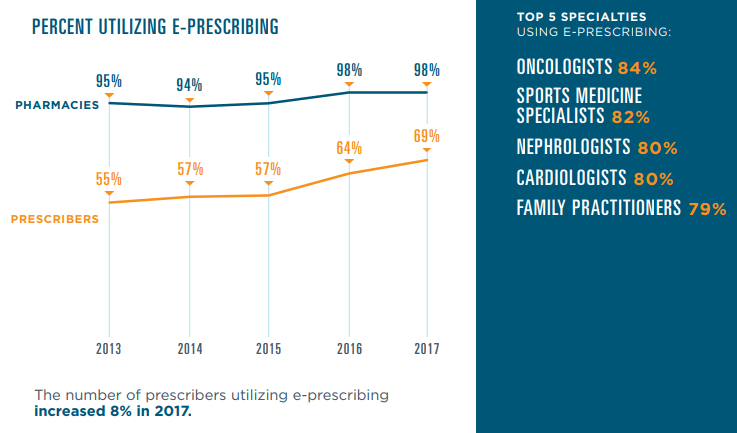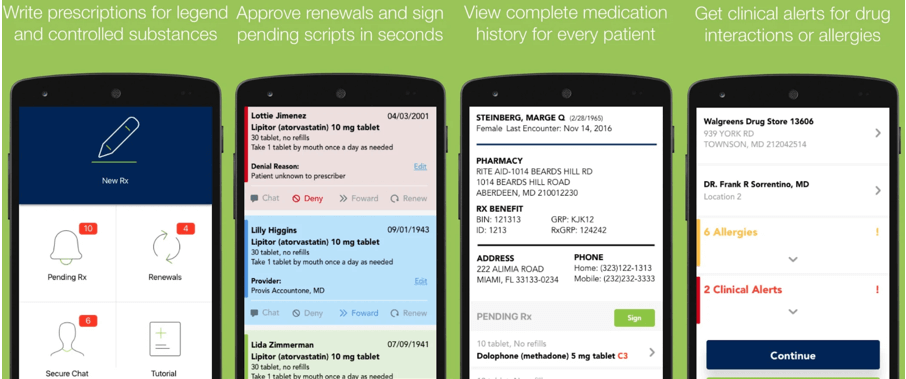Jan 3
2019
Is ePrescribing a Niche Worth Moving Into?
By Dmitry Garbar, partner, Belitsoft.

Errors in prescription can happen for various reasons, like pharmacists’ incompetence, miscommunication between clinicians or doctor’s bad handwriting. Among medication errors, prescription inaccuracy is one of the major causes of concern for healthcare professionals. Today’s most effective technological solution is to implement an electronic prescribing system. With the help of e-prescribing software, prescription errors can be prevented in 80 percent of cases. It is also an actual solution for the opioid epidemic that puts Americans’ lives at risk.
The results, indeed, are impressive. But at the same time, eRx systems are considered inconvenient and costly for small practices. We’ve tried to explore e-prescribing market and identify the main problems of widespread system adoption.
Hitchhiker’s guide to eRx
Electronic prescribing (eRx) is a system that enables healthcare providers to generate digital prescriptions and send them to pharmacies directly from the point of care. e-Prescribing, in fact, improves accuracy, enhances patient safety and quality of care since there is no handwriting.
Standards for transmitting, recording and describing prescriptions have been created by the National Council for Prescription Drug Programs (NCPDP). There are two main types of e-prescribing systems:
- Systems integrated with EHRs, which include comprehensive patient data.
- Stand-alone systems, which means that they can be used only for e-prescribing.
Some eRx systems offer advanced features that allow healthcare providers to access generic medication alternatives, insurance benefit info, and patient medication lists and histories. These extra features have the potential to improve physicians’ decision-making capabilities and increase the use of e-prescribing systems.
E-prescribing market analysis
A prospective EHR vendor has to comply with the regulatory requirements of their customers and know how to develop e-prescribing software. But is investing in eRx worth it?
According to the recent Transparency Market Research, the global market for e-prescribing is expected to reach a CAGR (Compound Annual Growth Rate) of 23.5 percent from 2013 to 2019. Persistent Market Research estimated that the market will reach $887.8 million in 2019.
While Europe holds the largest share in e-prescribing market, the US turned out to be the fastest-growing region. Indeed, increasing adoption of healthcare management software and extensive use of health IT for patient engagement are the key factors in industry growth. Furthermore, electronic prescribing is a requirement for healthcare providers aiming at achieving meaningful use under the Medicare and Medicaid EHR Incentive Programs.
What do prospective vendors need to begin with electronic prescribing?
- Contact NCPDP for transaction standards.
- Certify with appropriate network business partners.
- Contact CCHIT for certification requirements.
- See Meaningful Use information at gov
Major players on e-prescribing market: Cerner Corporation, DrFirst, HealthFusion, Surescripts, Allscripts Healthcare Solutions Inc., Aprima Medical Software, eClinicalWorks, athenahealth Inc. and Relayhealth Corporation.
To show what usability results you can expect, we have chosen the case of Surescript as an “open-source” company. Surescript is a VA-based operator of a nationwide electronic network for prescription-related data and information. Its platform connects EHRs, pharmacy benefit managers (PBMs), pharmacies and clinicians, plus health plans, long-term and post-acute care organizations.
Their 2017 National Progress report shows that 13.7 billion secure health transactions took place via the Surescripts network including 1.74 billio e-prescriptions. This is a 26 percent increase from 2016. This improvement was owing to five key elements: Drug Description, Representative National Drug Code (NDC), RxNorm, Structured and Codified Sig and Potency Unit Code.
Moreover, the network connected 1.47 million healthcare professionals — 13 percent more than in 2016 — with secure patient data for 233 million Americans, or 71 percent of the population.

Source: surescripts.com/docs/default-source/national-progress-reports/2151_npr_2017_finalB.pdf
Various government initiatives which focus on reducing medical errors, and the need to cut escalating healthcare costs foster the growth of the eRx market. The increasing cooperation between software vendors and network providers and the vast untapped regions are expected to provide significant development opportunities for industry players.
Electronic prescribing as a solution to the opioid crisis
Millions of Americans suffer from pain and are often prescribed opioids to treat their conditions. However, the danger of prescription misuse, opioid use disorder, and overdose have been a growing problem throughout the U.S.
Opioids are the leading cause of death for young Americans under 50, with as many as 64,000 overdose deaths in 2016, up from 52,000 in 2015. More than 40 percent of those deaths involved a prescription opioid.
Technology tools, such as e-prescribing and prescription drug monitoring programs (PDMPs), are of great service to healthcare professionals. The technologies address opioid over prescription and drug diversion, especially concerning the illegal use of prescription opioids.
To address the opioid crisis, DrFirst, an e-prescribing and medication management solutions provider, in partnering with MedChi, The Maryland State Medical Society, have developed iPrescribe. This mobile tool uses the SureScript national e-prescribing network to process electronic prescriptions. Thus, iPrescribe has access to pharmacies almost throughout the US.

iPrescribe is available on Google Play and Apple Store.
Source: play.google.com/store/apps/details?id=com.drfirst.iprescribepro&hl=en_US
Since July 2018, Maryland prescribers have been required to query and review the PDMP database before prescribing an opioid or benzodiazepine for a patient. This was a time-consuming task, as PDMP access involved leaving the clinical workflow to review the patient’s records of opioid and other controlled drug prescriptions.
The DrFirst’s solution allows accessing PDMP data from within the e-prescribing workflow. Physicians can make a fully-improved prescribing decision when providing proper pain medications to patients who need it, and identify those who are at risk for opioid addiction.
iPrescribe is compatible with most EHRs, with all prescriptions passed through the app automatically updated to a patient’s medication history. According to the company, their mobile app enables healthcare providers to complete their prescribing process three times quicker than usual and reduce the number of mistakes.
Problems of widespread e-prescribing adoption
Although the use of e-prescribing is increasing, healthcare providers still face challenges that may hinder the widespread implementation and effective use of eRx systems.
Present e-prescribing systems provide access to sensitive patient information, for example, patient medication histories, formulary data, and generic alternatives. These features enhance the basic ability to write and transmit prescriptions electronically but can cause usability challenges.
eRx system design varies by a software vendor, and the technology is often complex and time-consuming to use. Thus, some platforms require the prescriber to go through several steps to find necessary medication history. However, they should make that info readily available by prominently display it on the screen at the start of the prescribing session. The same applied to formularies, which allows clinicians to view a list of medications covered by the patient’s health plan. User-friendly eRx systems let the prescriber know if an entered medication is on a formulary, and if not, suggests an alternative. Low-quality systems require prescribers to manually check each medication by trial and error.
The financial cost of health IT support is one of the major barriers to implementing an e-prescribing system. Also, eRx platforms require basic technological infrastructure and training for proper installation and maintenance, which adds to the financial burden of their implementation. Other commonly identifies pitfalls include insufficient time for clinicians and staff to learn the new systems, lack of skilled personnel to handle the systems and risk of data breaches.
Conclusion
E-prescribing is a potential solution to increase patient safety and medication adherence. The market is developing; the key players offer advanced features, like accessing patient medication history or automatically seeing alternative treatment within a single app.
However, barriers to its widespread usage still exist, one of which is the cost of implementation. But this is an attractive field for investment, as its development is supported by government initiatives. Perhaps your eRx solution will save human lives and healthcare providers’ budgets.